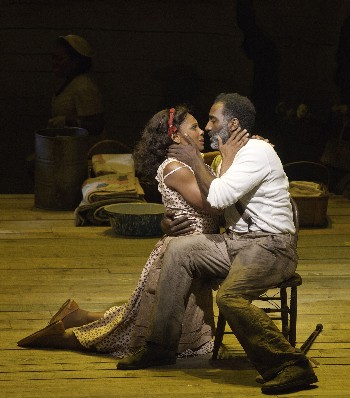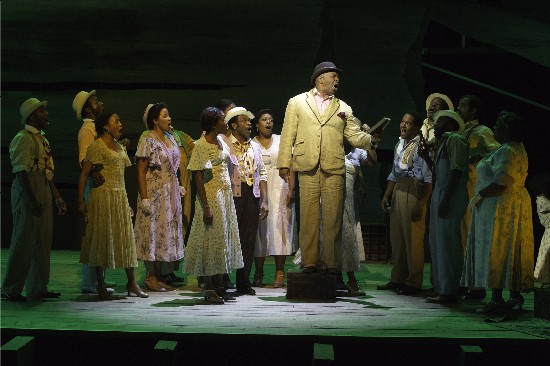Theater Review: A “Porgy and Bess” Made For Broadway
The American Repertory Theater’s juggling/removal of the operatic elements in Porgy and Bess is clumsy, but the goal is to create a compelling entertainment for contemporary audiences, smoothing out the melodramatic story’s edges and cutting its length.
The Gershwins’ Porgy and Bess by George Gershwin, Dubose and Dorothy Heyward, and Ira Gershwin. Directed by Diane Paulus. Adapted by Suzan-Lori Parks and Diedre L. Murray. Sets by Riccardo Hernandez. Costumes by Esosa. Orchestrations by William David Brohn and Christopher Jahnke. Music Supervision by David Loud. Staged by the American Repertory Theater at the Loeb Drama Center, Cambridge, MA, through October 2.
By Bill Marx

Audra McDonald (Bess) and Norm Lewis (Porgy) confess their love in the American Repertory Theater production of THE GERSHWINS’ PORGY AND BESS. Photo: Michael J. Lutch.
Porgy and Bess has always generated a grand and possessive passion among its admirers, so it shouldn’t be a surprise a ruckus has been raised by an adaptation of an American masterpiece that has posed identity problems from its premiere in the 1930s: Is it an opera? Musical theater? A hybrid of the two? Stephen Sondheim didn’t like what he read in a New York Times interview about how American Repertory Theater director Diane Paulus and adapters Suzan-Lori Parks and Diedre L. Murray aimed to make the show more immediate, streamlined, and relevant. In a letter to the Times, Sondheim indicated that to him the approach smacked of an attempt to arrogantly cut an unruly giant and its larger-than-life characters, which have pleased audiences for decades, down to byte size.
The ART production, enjoyable enough but lightweight, suggests that the huffing and puffing was needless—the original material is still around to be produced in all of its glory, safe from the well-meaning wiles of auteurs, on the concert or opera stage. This Porgy and Bess has been exactingly groomed, as well as sliced and diced, for Broadway intake, carefully tailored to fit the current sensitivities of New Yorker/tourist theatergoers as well as the possibilities of touring in the future. It speaks to the demographics of our time.
Thus the adaptation’s juggling/removal of the operatic elements in Porgy and Bess is awkward, but that is besides the point. The aim is to create a compelling entertainment for contemporary audiences, smoothing out the melodramatic story’s edges, cutting its length, and making sure the cues for our emotional reactions are clearly marked in each scene. The narrative momentum from set piece to set piece, as well as the slow accumulation of feeling from episode to episode, is clumsily handled—the evening is a concatenation of highlights, a parade of greatest hits. Some of the latter pack a dramatic wallop, particularly when they involve the marvelous Audra McDonald, who is a powerfully good Bess.
In this sense, this version’s whittled-down approach to the original predictably settles in the middle, neither fish nor fowl: it is far from the demanding opera, but not so far that you have a really bold revamping, which was (sort of) suggested in the New York Times interview.
The result is an opportunity to hear the wonderful Gershwin score, while having questionable political suggestions and stereotypes excised, the plot buffed up to a Great White Way shine, the minimal set (it looks as if the cast is acting in a giant picnic basket) contoured for quick action, the singing and dancing denizens of Catfish Row at times appearing to be trying out for The Color Purple, and an ending that is schmaltzed up a bit for those who like to walk out of an expensive evening at the theater with a whiff of the indomitable up their noses.

David Alan Grier (Sporting Life) charms the company in THE GERSHWINS’ PORGY AND BESS. Photo: Michael J. Lutch
For me, the most interesting aspect of the adaptation is its earnest, puritanical streak. The impressive Phillip Boykin is powerfully threatening as Bess’s murderous lover, Crown, but there’s no sexual allure in his characterization—he is all brute. More problematic is the low-key evil of David Alan Grier’s Sporting Life, who is told off for his drug-dealing ways by the good citizens of Catfish Row, but the performer proffers precious little in the way of mischievous charisma in response. The illicit good life may be the devil’s delusion, but it has to dazzle as well as frighten—this Sporting Life, with his wrinkly suit, skulking ways, and half-hearted dancing, exudes low-wattage comic energy, but he comes off as a man whose days of alluring decadence are well behind him. New York City will eat him alive.
As Porgy, Norm Lewis sings with a sweetly plaintive power (his “I Loves You Porgy” duet with McDonald attains a heart-breaking poignancy), but he doesn’t develop his character so much as circle in a stolid place. Hobbling around on a cane, then trying out a pair of braces, Lewis lets the hardware suggest the emotional changes that are taking place internally, the intertwined growth of love and the need for possession.
The multiple Tony award-winning McDonald takes up the challenge, exploring, in her singing and performance, the complex arc of the character’s torturous inner life—arrogance, fear, courage, love, horror, and finally back to fear. She sings with a forceful purity, sometimes working a bit too hard, but McDonald’s voice is worthy of the Gershwin music, the bluesy, gospelish spell cast by tunes such as “Summertime,” “It Ain’t Necessarily So,” “There’s a Boat Leaving Soon,” and others. Aside from some rough patches and the occasional clunky transitions from scene to scene, the ART orchestra plays with pleasurable dispatch.
Porgy and Bess is a show that reaches for the sublime, that is capable of challenging, even overwhelming, audiences. This version is generally an efficient show-biz facsimile, genius packaged for ease of consumption.
Susan Miron on the recent production of Porgy and Bess at Tanglewood.
Bill Marx is the editor-in-chief of The Arts Fuse. For over three decades, he has written about arts and culture for print, broadcast, and online. He has regularly reviewed theater for National Public Radio Station WBUR and The Boston Globe. He created and edited WBUR Online Arts, a cultural webzine that in 2004 won an Online Journalism Award for Specialty Journalism. In 2007 he created The Arts Fuse, an online magazine dedicated to covering arts and culture in Boston and throughout New England.
Tagged: American Repertory Theater, Audra McDonald, Diedre L. Murray, Porgy and Bess

God, I love Gershwin for having written this. He defied every stereotype of his era.
I find it interesting that so far the reviews I’ve read have all been by theater critics rather than musicians/music critics. I would be astounded to read from a musician that “the juggling of the operatic elements is awkward, but that is beside the point.” Music—be it in music theater or opera—is NOT beside the point in Gershwin, despite what their estates sanction.
It should sound much better than it did the evening I attended Porgy and Bess. Singers were miked, as they would be on Broadway where it’s headed, but this was distracting and unnecessary. The orchestra was, particularly in the four strings, scrawny in sound, and the singers often sang intervals lower than the songs had been written for so they would sing it in their chest voices, as is often done on Broadway. One example of this was Clara’s opening “Summertime,” which was lowered by several notes so that its high notes—according to musical director Diedre L. Murray—wouldn’t wake the baby with Gershwin’s customary high B. The result: this excellent singer sounded lousy because she was using her chest voice.
Conductor/pianist Bramwell Tovey at Tanglewood the week before played the “Jasbo Brown Blues” thrillingly, here the music was gone except for a few bars. This surely is one of the opera/show’s great musical moments.
I found this production, music-wise, unsatisfying and would only recommend it to those who had not heard Gershwin’s music before. Better to get recordings or DVDs of it. They have everything but Audra McDonald and Norm Lewis, but this Porgy Lite will doubtless be a hit . Sad. This is more than theater. Much more. Is this kind of production what lies in our musical theater future?
Good points, Susan.
I would add that over the past decade or so Broadway musical productions have not focused strongly on the quality of the musical experience. These productions are packaged to run for months, with the focus on putting in a star that makes the presentation commercial: in the case of Porgy and Bess, there’s Audra McDonald, an outstanding singer and performer; David Alan Grier is a known quantity who gives a mediocre performance as Sporting Life.
This production is not designed to run for a performance or two, as at Tanglewood—it is put together to succeed as long-running musical theater today. Thus the smoothing out, the domesticating, the sense of rolling out the Gershwins’ greatest hits. There was never a real chance that director Diane Paulus would do a radical rethink—it would not make for good box office, it wouldn’t tour, etc.
There has been a concerted effort by producers (especially touring organizations) to reduce the number of musicians in the orchestra, to the point that computers and recordings have been trotted out. The size of the ART orchestra is actually large given what is happening elsewhere. But the undercutting of the quality of the musical experience in musical theater continues. Until critics and audiences rebel strongly enough the decay will continue.